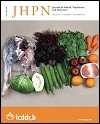Factors Associated with Food Insecurity in Households of Public School Students of Salvador City, Bahia, Brazil
DOI:
https://doi.org/10.3329/jhpn.v31i4.20002Keywords:
Food insecurity, Socioeconomic inequalities, Students, BrazilAbstract
This cross-sectional study was conducted to find out the factors associated with food insecurity (FI) in households of the students aged 6-12 years in public schools of Salvador city, Bahia, Brazil. The study included 1,101 households. Food and nutritional insecurity was measured using the Brazilian Food Insecurity Scale (BFIS). Data on socioeconomic and demographic characteristics as well as environmental and housing conditions were collected during the interviews conducted with the reference persons. Multivariate polytomous logistic regression was used in assessing factors associated with food insecurity. We detected prevalence of food insecurity in 71.3% of the households. Severe and moderate forms of FI were diagnosed in 37.1% of the households and were associated with: (i) female gender of the reference person in the households (OR 2.21, 95% CI 1.47-3.31); (ii) a monthly per-capita income below one-fourth of the minimum wage (US$ 191,73) (OR 2.63, 95% CI 1.68-4.08); (iii) number of residents per bedroom below 3 persons (OR 1.91, 95% CI 1.23-2.96); and (iv) inadequate housing conditions (OR 1.84, 95% CI 1.12-4.49). Socioeconomic inequalities determine the factors associated with FI of households in Salvador, Bahia. Identifying vulnerabilities is necessary to support public policies in reducing food insecurity in the country. The results of the present study may be used in re-evaluating strategies that may limit the inequalities in school environment.
DOI: http://dx.doi.org/10.3329/jhpn.v31i4.20002
J HEALTH POPUL NUTR 2013 Dec; 31(4): 471-479
Downloads
476
341

